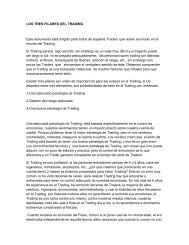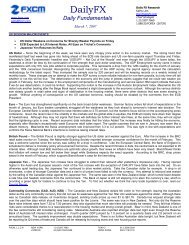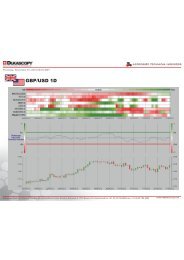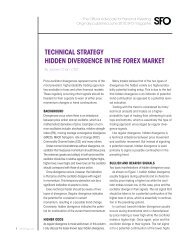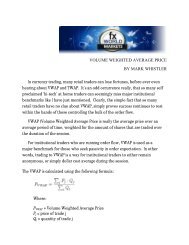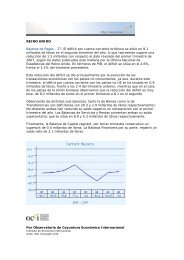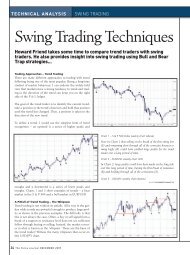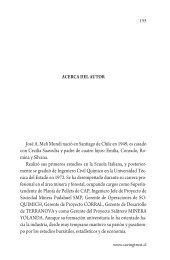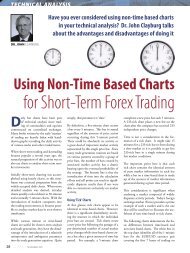Combining Japanese Candlesticks with Western ... - FXstreet.com
Combining Japanese Candlesticks with Western ... - FXstreet.com
Combining Japanese Candlesticks with Western ... - FXstreet.com
Create successful ePaper yourself
Turn your PDF publications into a flip-book with our unique Google optimized e-Paper software.
FEATURED ANALYSIS<br />
<strong>Combining</strong> <strong>Japanese</strong> <strong>Candlesticks</strong><br />
<strong>with</strong> <strong>Western</strong> Technical Analysis for<br />
a High-Probability Forex Trading<br />
Combination...<br />
James Chen discusses<br />
Candlestick patterns and how<br />
to <strong>com</strong>bine their interpretation<br />
<strong>with</strong> <strong>Western</strong> technical analysis<br />
methods to foster high probability<br />
trading.<br />
10 The Forex Journal DECEMBER 2009
Most Forex traders are familiar <strong>with</strong><br />
candlestick charts, as this method of<br />
depicting prices has be<strong>com</strong>e the standard<br />
format on many Forex charting<br />
platforms. What many Forex traders<br />
may not be aware of is how well candlestick<br />
patterns function when <strong>com</strong>bined<br />
<strong>with</strong> elements of <strong>Western</strong> technical analysis, such as<br />
support and resistance, bar chart patterns and the like.<br />
To provide a brief introduction to candlestick charting as a<br />
financial analysis tool, it was introduced relatively recently to<br />
the <strong>Western</strong> world from its origins in the historic rice trading<br />
markets of Osaka, Japan. Steve Nison, a prominent U.S. technical<br />
analyst, was responsible for bringing this ancient, yet<br />
innovative, <strong>Japanese</strong> chart-reading technique to <strong>Western</strong><br />
investors. He translated esoteric <strong>Japanese</strong> financial texts into<br />
English and published several works on this ancient charting<br />
approach. Nison has been so successful in propagating the<br />
<strong>Japanese</strong> method of candlestick charting that it has now superseded<br />
the popularity of bar charts in many financial markets,<br />
including Forex.<br />
The structure of a candlestick chart is significantly different<br />
from a bar chart. Candlestick charts contain all of the same vital<br />
price elements that are contained in bar charts. The difference<br />
lies in the visual representation of these elements. Included<br />
<strong>with</strong> the simple representation of price in candlesticks is an<br />
entire repertoire of colorfully named candlestick patterns that<br />
provide potential indications and confirmations of possible<br />
future price behavior.<br />
To start <strong>with</strong> the bare basics, the physical structure of a candlestick<br />
appears much like a candlestick in the non-financial<br />
context. There is the candle body that represents the prices<br />
between the candle’s open and close, and then there are the<br />
wicks (or shadows) that represent the high and low extremes<br />
where price traveled during the duration of the candle. Figure<br />
1 shows a basic candlestick illustration.<br />
Figure 1: Candlestick Structure<br />
Candles work for all financial markets, but are slightly different<br />
for the Forex market because of its unique 24-hour trading<br />
characteristic <strong>with</strong> the lack of gaps. As a result of the uniqueness<br />
of Forex, there is a subset of candle patterns that many<br />
Forex traders focus on. These patterns include doji, spinning<br />
INSIGHT JAMES CHEN<br />
TEXT JAMES CHEN<br />
tops, hammers, shooting stars, hanging men, inverted hammers,<br />
engulfing patterns, and harami.<br />
Virtually all candlestick proponents, including Nison himself,<br />
advocate the use of candles to confirm or be confirmed by<br />
<strong>Western</strong> technical analysis, rather than being used as the primary<br />
means for making trading decisions. Candlestick patterns<br />
are best at confirming or warning of potential reversals, when<br />
used in conjunction <strong>with</strong> <strong>Western</strong> technical indicators.<br />
One of the key elements of candlesticks that make them useful<br />
in warning of potential reversals is the phenomenon of long<br />
wicks (or shadows). Long wicks suggest indecision, price rejection,<br />
and a potential failure of the market to continue in the<br />
same direction. When used <strong>with</strong> <strong>Western</strong> technicals, these candlestick<br />
patterns can be extremely effective signals.<br />
“One of the key elements of<br />
candlesticks that make them<br />
useful in warning of potential<br />
reversals is the phenomenon<br />
of long wicks (or shadows).”<br />
Elements of <strong>Western</strong> technical analysis that are most effectively<br />
used <strong>with</strong> candlesticks center on support and resistance<br />
identifiers. These include horizontal support and resistance<br />
lines where price has turned or reversed in the past; uptrend<br />
support lines and downtrend resistance lines; <strong>Western</strong> bar chart<br />
patterns; Fibonacci retracements and extensions; pivot points;<br />
and volatility bands like Bollinger bands.<br />
Candlestick patterns contribute to an overall high-probability<br />
approach to trading Forex because they provide strong additional<br />
rationale for getting into a given trade setup. In other<br />
words, candlestick patterns help establish confluence. The vitally<br />
important concept of confluence <strong>with</strong>in the realm of technical<br />
trading may mean different things to different traders. The<br />
basic idea is that multiple technical confirmations make for a<br />
stronger trade rationale, and a higher-probability trade.<br />
Confluence simply means more than one technical indication<br />
providing a basis for any given trading action. This could be any<br />
<strong>com</strong>bination of two or more technical factors pointing in the<br />
same direction. Some examples of these technical factors<br />
include: support/resistance levels, trendlines, Fibonacci levels,<br />
pivot points, <strong>Western</strong> bar patterns, <strong>Japanese</strong> candlestick patterns,<br />
moving averages, volatility bands, and many more.<br />
DECEMBER 2009 The Forex Journal 11
FEATURED ANALYSIS<br />
As previously mentioned, there are several candlestick<br />
patterns that are especially well suited to<br />
confirming <strong>Western</strong> technical analysis methods in<br />
the Forex market. These include doji, spinning<br />
tops, hammers, shooting stars, hanging men,<br />
inverted hammers, engulfing patterns, and harami. Figures 2<br />
and 3 show illustrations of these candlestick patterns.<br />
Figure 2: Candlestick Patterns<br />
Figure 3: More Candlestick Patterns<br />
12 The Forex Journal DECEMBER 2009<br />
The Doji<br />
Of all candlestick patterns, perhaps the “doji” is the simplest<br />
of all. Representing supreme indecision in the market, a doji is<br />
formed when a candle’s open and close are either equal or very<br />
close to equal. After the doji opens, price may go up and/or<br />
down substantially, creating candle shadows in the process, but<br />
should close at or very near the opening price. Again, this pattern<br />
represents indecision, or a tug-of-war,<br />
between buyers (bulls) and sellers (bears).<br />
With additional technical confirmation, a<br />
doji is often considered a trend reversal<br />
indication.<br />
Spinning Top<br />
Another sign of indecision similar to the<br />
doji is the “spinning top.” A spinning top<br />
has a very small real body (though not as<br />
small as the single line of a doji) <strong>with</strong><br />
upper and lower shadows that are longer<br />
than the vertical length of the real body.<br />
Spinning tops can also indicate potential<br />
trend reversals <strong>with</strong> additional technical<br />
confirmation.<br />
The spinning top and doji both send the<br />
primary message that price closed the<br />
trading period (candle) at or around the<br />
same price at which it opened. Between<br />
the open and close, price may have moved<br />
significantly in either direction, or in both<br />
directions. This signifies that the market is<br />
undecided as to which direction to take. It<br />
can also signify a potential neutralizing of<br />
any previous trend that might have been<br />
in place, as countertrend forces may be<br />
slowing down the progress of trend forces<br />
in a hotly contested tug-of-war.<br />
Hammers<br />
“Hammers” can be strong confirming<br />
indicators of potential trend reversals to<br />
the upside. A hammer candle occurs after<br />
a downtrend. Its appearance is top-heavy<br />
<strong>with</strong> the real body being either color,<br />
(bullish or bearish). Very importantly, a<br />
hammer has a long lower shadow – this is<br />
the most important aspect of this candle.<br />
It signifies that the previously prevailing<br />
bears attempted to push price lower, but<br />
failed. While failures of this nature can<br />
often be the catalyst for reversing a downtrend,<br />
a hammer candle pattern, like<br />
other candle patterns, should only be used<br />
as a confirmation tool.<br />
Shooting Star<br />
What a hammer candle is to a down-
trend, a “shooting star” candle is to an uptrend. Essentially the<br />
opposite of a hammer, a shooting star is bottom-heavy <strong>with</strong> a<br />
long upper shadow. The color of the real body (whether bullish<br />
or bearish) is unimportant. Shooting stars follow uptrends,<br />
much like hammers follow downtrends, and indicate potential<br />
uptrend reversals.<br />
The long upper shadow of a shooting star is the<br />
most important aspect of the pattern, as it signifies<br />
that the previously prevailing bulls<br />
attempted to push price higher, but failed.<br />
Much like hammers, while failures of this<br />
nature can often be the catalyst for reversing<br />
an uptrend, a shooting star candle pattern<br />
should only be used as a confirmation tool, and not as a primary<br />
decision tool.<br />
Hanging Man<br />
A “hanging man” candle looks identical to a hammer candle,<br />
but occurs after an uptrend, instead of a downtrend. Just like<br />
the hammer, a hanging man is top-heavy <strong>with</strong> the real body and<br />
has a long lower shadow. The color of the real body is also irrelevant.<br />
As a hanging man should follow an uptrend, it can be<br />
considered a confirmation of a potential uptrend reversal.<br />
However, its signal arguably carries less weight than a hammer<br />
or a shooting star in its ability to signify a reversal confirmation,<br />
as a hanging man opens and closes near the top of its range<br />
after an uptrend. Therefore, the element of failure is not nearly<br />
as strong as <strong>with</strong> hammers and shooting stars.<br />
Inverted Hammer<br />
Similarly, an “inverted hammer” looks identical to the appearance<br />
of a shooting star candle, but occurs after a downtrend,<br />
Figure 4: Shooting Star at Resistance<br />
INSIGHT JAMES CHEN<br />
instead of after an uptrend. Just like the shooting star, a hanging<br />
man is bottom-heavy <strong>with</strong> the real body and has a long<br />
upper shadow. The color of the real body is also irrelevant. As<br />
an inverted hammer should follow a downtrend, it can be considered<br />
a confirmation of a potential downtrend reversal.<br />
However, like the hanging man, its signal arguably carries less<br />
weight than a hammer or a shooting star in its ability to signify a<br />
reversal confirmation, as an inverted hammer opens and closes<br />
near the bottom of its range after a downtrend. Therefore, as <strong>with</strong><br />
hanging man patterns, the element of failure in inverted hammers<br />
is not nearly as strong as <strong>with</strong> hammers and shooting stars.<br />
Bullish Engulfing Pattern<br />
The “bullish engulfing pattern” is a bullish reversal pattern<br />
that usually occurs after a downtrend. It is a two-candle pattern<br />
that is most often considered a reversal indicator. The first candle<br />
has a small bearish real body and the second candle has a<br />
large bullish real body that <strong>com</strong>pletely en<strong>com</strong>passes the first<br />
candle’s real body range. The concept behind this two-candle<br />
pattern is that the small body of the first candle represents hesitancy<br />
to continue a downtrend, while the large body of the second<br />
candle represents the bulls overpowering the previously<br />
prevailing bears, potentially reversing the downtrend.<br />
Bearish Engulfing Pattern<br />
In an opposite fashion, the “bearish engulfing pattern” is a<br />
bearish reversal pattern that usually occurs after an uptrend. It is a<br />
two-candle pattern that is most often considered a reversal indicator.<br />
The first candle has a small bullish real body, and the second<br />
candle has a large bearish real body that <strong>com</strong>pletely en<strong>com</strong>passes<br />
the first candle’s real body range. The concept behind this two-candle<br />
pattern is that the small body of the first candle represents hesitancy<br />
to continue an uptrend,<br />
while the large body of the second<br />
candle represents the<br />
bears overpowering the previously<br />
prevailing bulls, potentially<br />
reversing the uptrend.<br />
SOURCE FX SOLUTIONS - FX ACCUCHARTS<br />
Harami<br />
The opposite of an engulfing<br />
pattern is a “harami” pattern.<br />
It is a two-candle pattern<br />
that consists of a large body<br />
followed by a smaller, en<strong>com</strong>passed<br />
body of the opposite<br />
color. Therefore, a harami<br />
pattern can either be a large<br />
bullish candle followed by a<br />
small bearish candle, or a<br />
large bearish candle followed<br />
by a small bullish candle. Like<br />
engulfing patterns, harami<br />
patterns are also considered<br />
potential reversal indicators.<br />
DECEMBER 2009 The Forex Journal 13
FEATURED ANALYSIS<br />
Figure 5: Hammer at Fibonacci Retracement Level (61.8%)<br />
Harami patterns represent indecision after strong trends, as<br />
is evidenced by the small body of the second candle in the pattern.<br />
When <strong>com</strong>bining <strong>Japanese</strong> candlesticks <strong>with</strong> <strong>Western</strong> technical<br />
analysis, the key is to identify candlestick patterns right at or<br />
near significant price areas as defined by elements of <strong>Western</strong><br />
technical analysis.<br />
One of the strongest of such instances occurs when a hammer<br />
or shooting star candlestick pattern occurs at support or<br />
resistance, respectively. This is due to the fact that hammers<br />
and shooting stars represent price rejection – a failure of price<br />
to continue in the previously prevailing direction.<br />
When a hammer occurs right at or near a strong support level<br />
(where price has turned up at least once in the past) after a<br />
defined downtrend, there is a significant chance that a bullish<br />
reversal is in the making. Likewise, when a shooting star occurs<br />
right at or near a strong resistance level (where price has turned<br />
down at least once in the past) after a defined uptrend, there is<br />
a significant chance that a bearish reversal is in the making. An<br />
example of this is shown in Figure 4 (left).<br />
The same can be said for hammers and shooting stars showing<br />
price being rejected, or failing, at significant Fibonacci levels<br />
(as shown in Figure 5, above), pivot points, and Bollinger<br />
Band extremes.<br />
14 The Forex Journal DECEMBER 2009<br />
Other potential reversal candlestick patterns like doji, spinning<br />
tops, hanging men, inverted hammers, engulfing patterns<br />
and harami that occur at significant support or resistance levels,<br />
Fibonacci levels, pivot points or Bollinger Bands also raise the<br />
probability of an impending reversal.<br />
When utilizing <strong>Japanese</strong> candlestick patterns in conjunction<br />
<strong>with</strong> <strong>Western</strong> technical analysis elements, one of the key concepts<br />
to keep in mind is that the stronger and greater number<br />
of signals pointing to a significant price event like a trend reversal<br />
or turn, the better the chance that a turn will actually occur.<br />
This is the ideal of confluence, and it fosters a high-probability<br />
Forex trading environment. TFJ<br />
James Chen, CTA, CMT, is Chief Technical Strategist at FX<br />
Solutions, a leading Forex broker. He is a registered Commodity<br />
Trading Advisor and a Chartered Market Technician, as well as the<br />
author of the book, Essentials of Foreign Exchange Trading (John Wiley<br />
& Sons, 2009). His newest book, Essentials of Technical Analysis for<br />
Financial Markets (John Wiley & Sons) will be released in early 2010.<br />
SOURCE FX SOLUTIONS - FX ACCUCHARTS



![Hedge [Modo de compatibilidad] - FXstreet.com](https://img.yumpu.com/17927360/1/190x135/hedge-modo-de-compatibilidad-fxstreetcom.jpg?quality=85)
